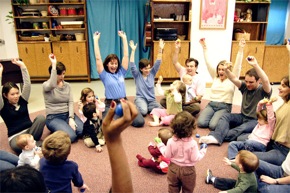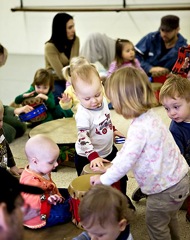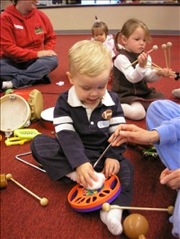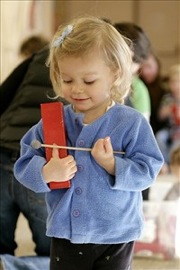
Featured Video
Related Articles
When Should Children Begin Music Lessons?
Part of SFCV's NEW Tips & Advice series for families with children interested in classical music
Musical Outreach on the Front Lines
For more articles like this one at our new section:Kids & Families
Meet Levi. On Wednesday mornings in an airy dance room in Oakland’s Rockridge neighborhood, he sings and dances joyously to tunes from around the globe. Sometimes he drums, keeping a perfect beat. He is also a liaison of sorts, welcoming the more reserved to join the merriment. He has even helped inspire his own mother — a civil engineer who has never been very comfortable with music — decide to take up the guitar after wanting to try it all her life.
Levi, for all his accomplishments, is a sapling of a lad — just 18 months old. He’s a student at East Bay Music Together, a branch of the internationally recognized early childhood music and movement program, Music Together. Classes are so much fun that kids have no idea they’re developing important musical skills that will stay with them for life.
“He’s getting so much from these wonderful classes,” says Levi’s mom, Christine Gharagozian. “And I think I’m getting just as much.”
This is no strict school, built on rule-following and rote learning. In a recent music class, during his bouts of musical bliss, Levi stuck a maraca in his mouth after keeping rhythm with it for a while. And he was so mesmerized by a pair of shiny rhinestone-encrusted little pink shoes he found that he carried them around class, following their rosy gleam as if they were a coveted treasure.
Did Levi get called out? No way.
“It’s all part of the learning experience at Music Together,” says East Bay Music Together teacher Andy Fullington, a professional soprano and beloved long-time Music Together teacher. “It just goes along with the joy of music making at this age, in a group setting, with the great dynamic we have here.”
All Children Are Musical

In 1987, Music Together launched its research-based program focusing on children from infants up to about five years old. Its core concept: All children are musical, and all children can learn to sing in tune and keep a beat. They just need the right kind of environment.
That kind of environment is now in more than 2,000 communities worldwide, thanks to Music Together’s ever-increasing popularity.
In 1997, music teacher Julie Tanenbaum became such a fan of the program that she founded East Bay Music Together. Her passion for the program grows every year, as does the demand for her classes, which she and several other teachers give at several locations throughout the East Bay.
“Music Together is dedicated to providing the best early-childhood music education possible,” says Tanenbaum. “This means providing a rich, fun, developmentally appropriate environment with adult involvement, in which children's inborn musical aptitude is developed to its fullest.
What separates Music Together from other early-childhood music programs? Many things, according to Tanenbaum, including:
• The research basis of the program: Music Together is based on groundbreaking research into the importance of the caregiver model in early childhood musical development. The program operates a "lab" school in the Princeton, N.J. area, where researchers conduct different types of research on young children and music.

• The variety of “substantial” music: Children's music is often restricted to major scales (think Twinkle Twinkle Little Star) and duple meter, or march time. Music Together balances each song collection to include six to seven different kinds of scales, unusual meters and rhythms, songs from different cultures and in different moods and tempos, classical, jazz, world music and folk, and original music written for the program. Tanenbaum points to research showing that when exposed to a variety of different types of scales and complex rhythms, with adult modeling, children internalize these tonalities and complex rhythms as part of their “Musical Mother Tongue.”
“Scales that are unfamiliar, or rhythms that are unusual in our culture, like seven-beat patterns, can flummox a music conservatory student who did not hear these patterns in their musical developmental phase (birth to age 4 or 5),” says Tanenbaum. “With exposure during this time, these scales and rhythms are just part of one's musical vocabulary.”
• Music that’s appealing to children and parents: The program’s music is pitched in the right range for children’s voices, and includes songs, rhythmic chants, tonal and rhythm patterns, and instrumental play-alongs, all in a rich variety of tonalities and meters. Original songs and arrangements by the program’s authors make these collections especially unique, says Tanenbaum. And all of the songs are suitable for mixed-age groups, perfect for childcare centers or families with children of different ages. A fringe benefit: The music is parent-friendly. In other words, there’s no “Barney Effect” of mindless songs that drive adults mad.
• The extent of teacher training: Each teacher must pass a 30-hour training taught by a Music Together master teacher. At the East Bay center, trainees who have passed the training then apprentice for at least 10 weeks with one of the center’s most experienced teachers. After 100 hours of teaching, teachers are eligible to train (three days) for and be granted basic certification. More advanced certification takes years of teaching.
It’s Never Too Early
 One of the big questions Music Together staffers get is about how old a child should be to start in a Music Together class, or begin some form of musical exposure. The answer, says Tanenbaum, is simple. “It’s never too early to begin musical exposure for your child, just as it is never too early to begin speaking to babies.”
One of the big questions Music Together staffers get is about how old a child should be to start in a Music Together class, or begin some form of musical exposure. The answer, says Tanenbaum, is simple. “It’s never too early to begin musical exposure for your child, just as it is never too early to begin speaking to babies.”
In fact, research shows musical development seems to parallel language development. With exposure, infants' brains begin to collect the sounds of melody and harmony, and the feel of steady rhythm, leading to the formation of neural connections. These connections form the infrastructure for all music making, says Tanenbaum. East Bay Music Together offers baby classes at most of its locations.
And the benefits for all levels of the tot music classes are profound beyond developing musical competence, according to teachers. Because of the way they’re structured, classes offer physical, intellectual, emotional, and social benefits. Shy kids come out of shells and even become leaders. Neurons connect in ways they would not otherwise.
Of course, when you’re in a room full of happy kids and parents, and they’re dancing with tie-dye scarves or blowing out the lights on the ceiling or shaking a tambourine to an uplifting reggae beat or making plans for an outing to the local Mexican restaurant after class, all the research and studies on the benefits of these classes fly out the window.
“It’s just so much fun for everyone, and a real bonding experience,” says Gharagozian. “Everyone I know loves it here. Getting to know music is just part of it.”
Levi appears to agree. He walks up to his mom and gives her a big smile. Then he trots off to see what’s going on with a little girl on the opposite side of the circle. She is holding a most lustrous triangle, you see, and he would like to be her friend and clang the triangle and see if they can make beautiful music together.
School Awards:
- Bay Area Parent Magazine Hall of Fame: Best Music Class 2001-2010
- Berkeley Parents Network: Best Music Class
- Lamorinda Moms: Best Music Class
- East Bay Express: Best Music Class
